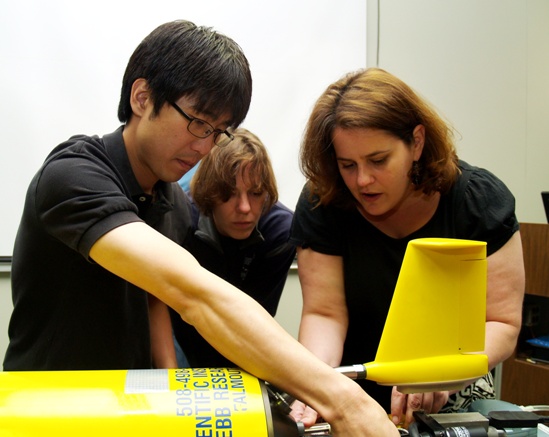Sometimes scientific advances provide answers, and sometimes, they simply present more questions. That is what happened when scientists began using satellite imagery to study the ocean.
When Skidaway Institute of Oceanography scientists Jim Nelson and Catherine Edwards looked at satellite imagery of the ocean off the Carolinas, they noticed persistent blooms of phytoplankton, an important part of the marine food web. These mysterious blooms occurred during the winter along edge of the continental shelf off Long Bay — located between Cape Romain, South Carolina and Cape Fear, North Carolina. Phytoplankton blooms like those observed off Long Bay can provide a considerable boost to the bottom of the food chain, with significant implications for fisheries.
“The immediate cause of the blooms is an input of nutrients, like nitrogen and phosphorous, associated with transport and mixing of deep, cold onto the continental shelf,” said Edwards. “The Long Bay blooms persist for weeks or even months during the winter, suggesting multiple modes of nutrient input.”
Two of the guiding questions are why this feature is so persistent over the winter, and what are the dynamics that sustain this bloom?
Edwards and Nelson are teaming with Harvey Seim from the University of North Carolina and Fumin Zhang from Georgia Tech-Savannah on a project to answer those questions. The project is funded by a $1.6 million grant from the National Science Foundation supporting a team of scientists from all three institutions. With the help of Skidaway Institute research coordinators Trent Moore, Julie Amft and Charles Robertson, the project team will deploy moored and mobile instrument packages and conduct shipboard surveys to test hypotheses of how the winter blooms are formed and sustained.
The team will use some cutting-edge technology that will enhance its ability develop a clear picture of what is happening. This includes instrument packages mounted on moorings; mobile, autonomous “gliders”; underway ship surveys; standard ship-based station sampling; and satellite measurements of sea surface temperature and ocean color.

Skidaway Institute researchers (l-r) Catherine Edwards, Trent Moore, Julie Amft and Jim Nelson examine a glider.
Three moored packages will be deployed to provide continuous measurements of water properties and currents through the winter months. One mooring will be placed at 35 meters of depth, the approximate position of the shoreward edge of the winter bloom.
Two more packages will be placed in approximately 75 and 150 meters of water, with the 75 meter mooring equipped with an instrument package called a SeaHorse. Powered by wave motion, the Seahorse moves up and down its mooring wire, taking measurements throughout the water column. A telemetry system in the surface mooring periodically reports its observations.
The research team will also use another high-tech tool, autonomous underwater vehicles, also called gliders.

Skidaway Institute researchers lower a glider into a tank of water to adjust buoyancy and trim. (l-r) Trent Moore, Dongsik Chang, Charles Robertson and Julie Amft
Two of these torpedo-shaped vehicles, equipped with sensors and recorders, will provide the ability to collect observations under all conditions, including during winter storms when ship operations are not possible. The gliders will survey across the study area, taking and recording measurements as they go. From time to time over the four to five week missions, they will surface, report their data by satellite phone and receive instructions as needed.
The gliders will be controlled from shore with an autonomous glider control system co-developed by Fumin Zhang at Georgia Tech Savannah. Two Georgia Tech-Savannah graduate students, Klimka Szwaykowska and Dongsik Chang, are developing algorithms to optimize the glider sampling given real-time data collected by satellite, the SeaHorse profiler and the gliders themselves.

Catherine Edwards (r) and Dongsik Chang work on the tail of a glider while Klimka Szwaykowska looks on.
Members of the research team will spend much of the winter of 2012 aboard the Skidaway Institute research vessel R/V Savannah, conducting experiments and collecting data.
Armed with a better understanding of the physical processes that “fertilize” the outer shelf and how phytoplankton take advantage of the nutrient input, the research team will be able to answer larger questions about how biology and physics interact in Long Bay.
The project will run for three years.


